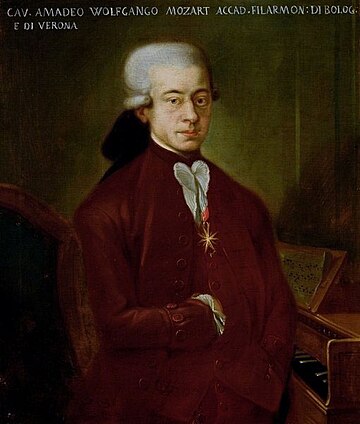Exsultate, jubilate (Exult, rejoice), K. 165, is a 1773 motet by Wolfgang Amadeus Mozart.
| Exsultate, jubilate | |
|---|---|
| Motet by W. A. Mozart | |
 Mozart in the 1770s | |
| Catalogue | K. 165 |
| Language | Latin |
| Composed | 1773: Milan |
| Performed | 17 January 1773 |
| Movements | 4 |
| Scoring |
|
History
This religious solo motet was composed when Mozart was staying in Milan[1]: 25 [2] during the production of his opera Lucio Silla which was being performed there in the Teatro Regio Ducale. It was written for the castrato Venanzio Rauzzini,[3][4] who had sung the part of the primo uomo Cecilio in Lucio Silla the previous year.[5] While waiting for the end of the run (from 26 December 1772 to 25 January 1773), Mozart composed the motet for his singer, whose technical excellence he admired. Its first performance took place at the Theatine Church on 17 January 1773, while Rauzzini was still singing in Mozart's opera at night.[6] Mozart made some revisions around 1780.[7] On 30 May 1779, a Trinity Sunday, a revised version was performed by Francesco Ceccarelli at the Holy Trinity Church, Salzburg. Another revised version was intended for Christmas. The manuscripts of the two Salzburg versions were discovered in 1978 in St. Jakob, Wasserburg am Inn.[2] While in modern times the motet is usually sung by a female soprano, it was also recorded by a number of countertenors, including Michael Maniaci, Franco Fagioli and Arno Raunig.
The autograph manuscript of the motet is preserved in the Jagiellonian Library.
Structure
| External audio | |
|---|---|
It has four sections:
- Exsultate jubilate – Allegro (F major)
- Fulget amica dies – Secco recitative
- Tu virginum corona – Andante (A major)
- Alleluja – Allegro (F major)
Musicologist Stanley Sadie called the final section, "Alleluia", "a jewel of a piece with its high spirits and its wit ... like no other piece of Mozart's; its music speaks unmistakably of his relaxed high spirits at the time he wrote it and of the elation and confidence that his opera-house success had brought him".[8]
Although nominally for liturgical use, the motet has many features in common with Mozart's concert arias, such as those drawn from his operas.[9] Mozart also used elements of concerto form in this motet.[1]: 41
Instrumentation
The motet is scored for soprano solo, 2 oboes (or 2 flutes), bassoon, 2 natural horns in F, organ, 1st and 2nd violins and violas, cello, and double bass.
The occasionally divided viola section gives the orchestra a richer sound.[10] This is something Mozart did more often, for example in his Sinfonia Concertante KV 364 in E-flat major for violin, viola and orchestra.
Libretto
Written in Latin, the author of the text is unknown but may have been Rauzzini.[11]
Exsultate, jubilate, |
Rejoice, resound with joy, |
Fulget amica dies, |
The friendly day shines forth, |
Tu virginum corona, |
You, o crown of virgins, |
| Alleluja, alleluja![2] | |
Revisions
The text of the first Salzburg version differs in the first and second section.[2]
Exsultate, jubilate, |
Rejoice, resound with joy, |
Tandem advenit hora, |
At last the hour has come |
The second Salzburg version differs from the previous only in the first section.[2]
Exsultate, jubilate, |
Rejoice, resound with joy, |
Recordings
- On Great Mass in C minor, K. 427, 1990 CD and DVD, Arleen Auger, Bavarian Radio Symphony Orchestra, Leonard Bernstein conducting
References
External links
Wikiwand in your browser!
Seamless Wikipedia browsing. On steroids.
Every time you click a link to Wikipedia, Wiktionary or Wikiquote in your browser's search results, it will show the modern Wikiwand interface.
Wikiwand extension is a five stars, simple, with minimum permission required to keep your browsing private, safe and transparent.
